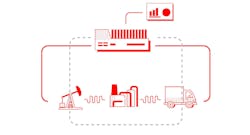The Gorgon Project, an expansive natural gas project located off the coast of Western Australia, is the largest single-resource development in Australia's history. Producing 2.1 billion cubic feet of natural gas and 15,000 barrels of condensate in 2020, the construction of Gorgon’s massive LNG trains directly employed more than 10,000 workers over a period of seven years – and cost project owners $54 billion.
The Challenges Facing Megaprojects
Facilitating multibillion-dollar construction projects has never been easy. Added pressures caused by the coronavirus pandemic and other challenges characteristic of our current time period are making it even harder. Here’s how:
- Supply chain disruptions are increasing material prices Disruptions to the supply chain brought about by the pandemic continue to have a profound impact on the price of construction materials, chief among them being lumber and steel. The price of 1,000 board feet of lumber soared from $347 to $1,675 between May 2020 and May 2021, while steel prices increased by a staggering 215% between March 2020 and July 2021. The steep hike in prices means it’s becoming even harder for megaprojects to stay within their allotted budgets. Some studies estimate that up to 98% of megaprojects fail to stay within their original budget constraints. The supply chain crisis certainly isn’t doing that figure any favors.
- Labor shortages continue to rock the construction industry Getting megaprojects off the ground requires skilled construction workers, and the U.S. simply doesn’t have enough of them. The Home Builder Institute predicts that the country needs an additional 2.2 million construction workers in the next three years to meet growing demand for housing alone. As record numbers of Americans quit their jobs in search of better wages, benefits and working conditions, the construction industry is feeling the pressure to attract skilled workers back into its ranks.
- Megaprojects require enhanced collaboration Managing projects that cost north of $1 billion requires unprecedented levels of clear communication, collaboration, and management. Unfortunately, most construction firms haven’t adjusted their workflows and processes to adapt to the unique needs of megaprojects. Construction firms still continue to work in silos, effectively creating a barrier to seamless collaboration across multiple departments. What’s more, megaprojects typically involve stakeholders across multiple international borders, only adding to collaboration and communication challenges.
The Gorgon Project: A Gargantuan Case For Digitalization
Throughout construction, the Gorgon Project utilized more than 250 preconstructed modules that were shipped to the job site for assembly. While modularization is lauded for offering increased time and cost efficiency in large construction projects, there was just one problem: the hand-off of the modules was all completed manually.
For the workers on the Gorgon construction site, that meant critical time was wasted on chasing down information and planning reactively – rather than proactively – in response to new developments. Without access to digital hand-off resources, such as an up-to-date digital twin or BIM, workers had to wait for the bill of lading (usually a fax or a low-resolution PDF) to know exactly what was being shipped and how. When the modules arrived at the job site, they had to manually ensure no components were missing. As a result, the workers scrambled to evaluate the project scope and had little time to plan until the last minute.
Having access to the right digital tools would have greatly improved the efficiency of the Gorgon Project by enhancing communication and planning capabilities.
HxGN SDx® Projects is an example of a digital technology that can enhance collaboration. HxGN SDx Projects enables all project stakeholders to view information in an up-to-date, consolidated dashboard, enabling seamless interdisciplinary communication. Users are notified automatically about actions through an automated workflow that tracks progress against your schedule and budget.
Artificial intelligence (AI) technology can also play a role in streamlining construction in megaprojects. Predictive analytics capabilities, for example, contractors can break down the costs and profitability of prior jobs, examine the accuracy of subcontractor bids received and determine where and how past projects ran into issues. Artificial intelligence can also enhance rationality in decision-making with forecasting models and prescriptive analytics. Not only does this help create more efficient workflows, but it also reduces the risk of accidents or safety hazards during construction caused by human error. When faced with hundreds of changing variables on a job site, humans’ decision-making capabilities are quickly diminished; AI helps address this by providing workers with data-backed solutions to help them make informed and timely decisions. The digital tools necessary to streamline collaboration across departments and stakeholders involved in megaprojects exist today and are readily available.
Digitalization: The Future Of Megaprojects
The challenges associated with megaprojects are multifaceted and complex, but digitalization currently presents itself as a readily available and viable solution. Of course, it stands to reason that digitalization on its own isn’t a magic bullet for improved megaproject work processes. To overcome the supply chain and labor force struggles impacting megaprojects, we’ll need to witness the decline of the coronavirus pandemic and an overhaul of the construction industry’s current recruiting and retention tactics. It will be years before we notice a reversal of the pandemic’s impact on the labor pool and supply chain.
In the interim, however, leveraging digital tools for greater efficiency and collaboration is a step in the right direction toward more successful, collaborative, and efficient megaprojects. As the construction industry trends towards megaprojects with increasing frequency, industry leaders would be wise to turn their eye towards the digital tools available to them – or risk reliving what workers on the Gorgon Project unfortunately endured.



